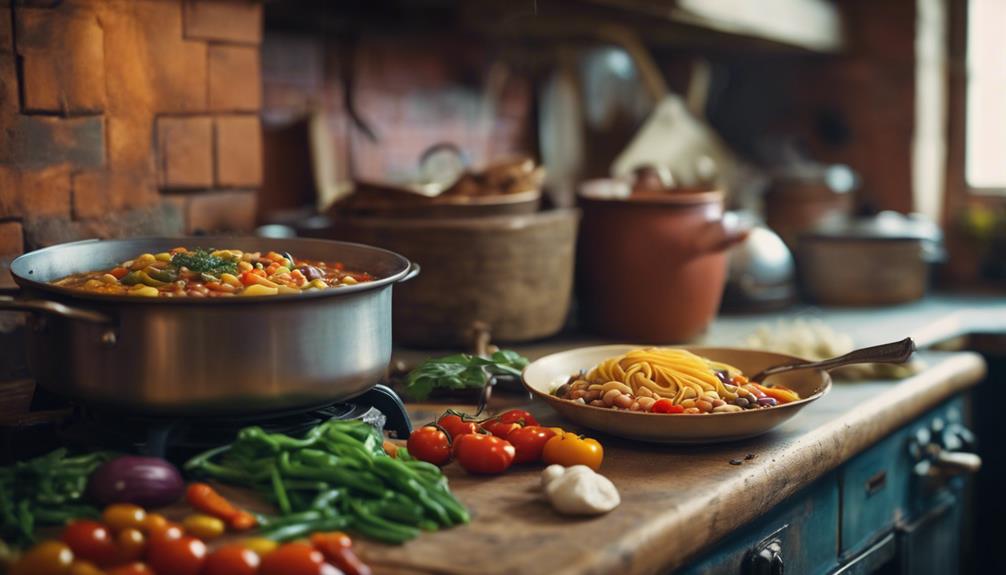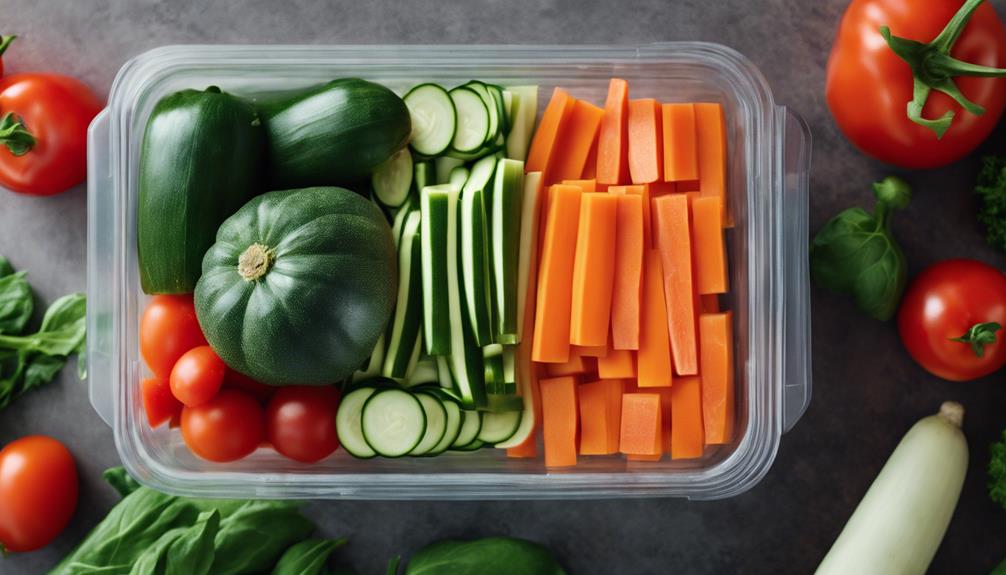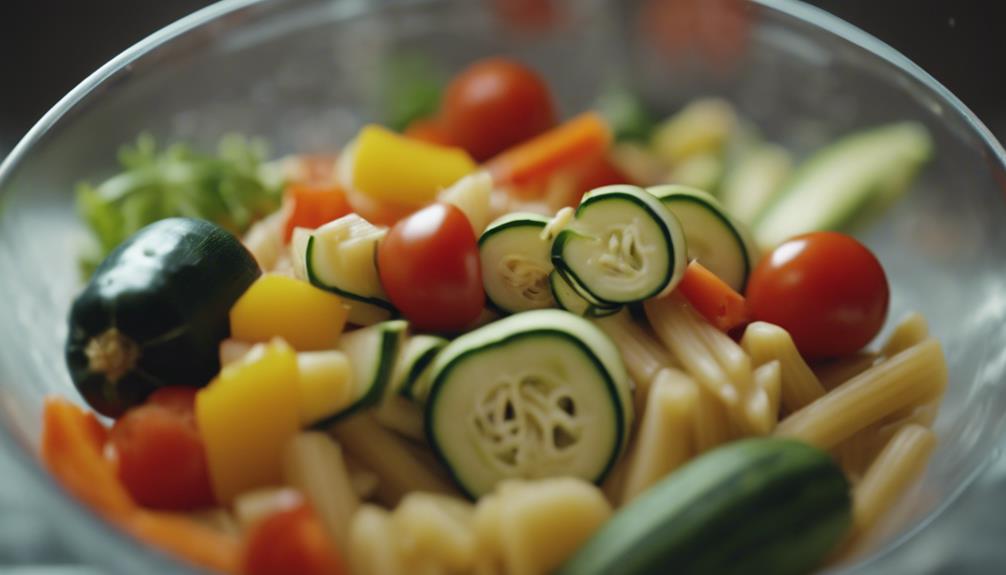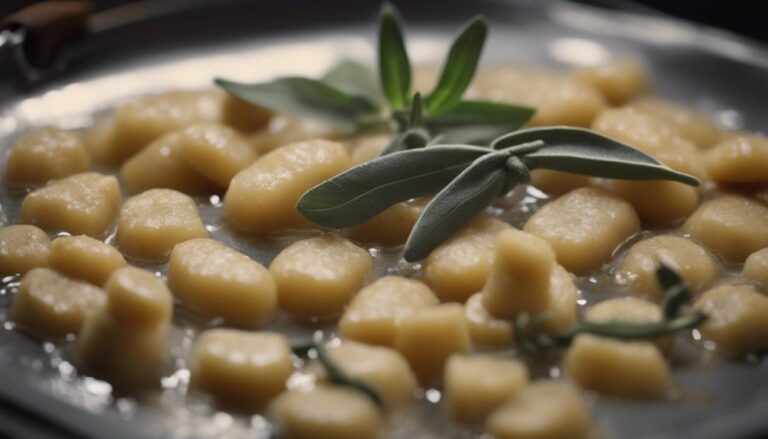Sous Vide Vegetable Minestrone With Whole Wheat Pasta
For a precise approach to crafting Sous Vide Vegetable Minestrone with Whole Wheat Pasta, set your temperature to optimize flavors. Carrots and potatoes shine at 183°F (84°C), while delicate zucchini thrives at 185°F (85°C). Embrace a nutrient-rich journey where vegetables retain vibrancy and nutrients, merging with whole wheat pasta's heartiness. Elevate traditional minestrone with sous vide precision, exploring a domain where flavors intermingle effortlessly, promising a colorful and nourishing experience. Subtly uncover the intricate dance of flavors awaiting in this vegetable-packed, flavorful venture.
What You Will Learn Here
- Sous vide cooking ensures precise temperature control for perfectly cooked vegetables.
- Whole wheat pasta adds a hearty element to the minestrone, enhancing nutritional value.
- Infusing flavors through sous vide elevates the taste profile of the vegetable minestrone.
- Vegetables retain nutrients and vibrant colors when cooked sous vide.
- Sous vide method allows for experimentation with vegetable combinations for a unique minestrone experience.
Origin of Minestrone Soup

The history of Minestrone soup traces back to ancient times, with roots in Roman cuisine. Traditional ingredients like vegetables, beans, and pasta have remained constant over the centuries.
The evolution of Minestrone has seen variations introduced based on regional produce and culinary preferences.
Minestrone Soup History
Originating from humble beginnings in ancient Italy, Minestrone Soup has a rich history intertwined with the evolution of Mediterranean cuisine. This iconic dish is deeply rooted in Italian culinary traditions, known for its farm-to-table approach that utilizes seasonal produce to create a hearty and nutritious meal.
Historically, Minestrone Soup was a simple peasant dish, making use of whatever vegetables were available locally. Over time, it has evolved into a versatile soup that can vary greatly in ingredients based on regional preferences and seasonal availability.
The essence of Minestrone Soup lies in its adaptability to incorporate a wide array of vegetables, beans, and grains, reflecting the diverse agricultural landscapes of Italy. Its history underscores the importance of utilizing fresh, seasonal ingredients to create a wholesome and flavorful dish.
Traditional Minestrone Ingredients
In tracing the genesis of Minestrone Soup, explore the foundational elements comprising traditional ingredients that form the bedrock of this iconic dish.
Traditional recipes for Minestrone typically encompass a rich assortment of seasonal ingredients, reflecting the culinary heritage of various regions.
Common components include a base of onions, carrots, and celery, known as a mirepoix, which provides depth and flavor.
Seasonal vegetables such as zucchini, green beans, and tomatoes are often incorporated, adding freshness and vibrancy to the soup.
Legumes like beans or lentils contribute protein and texture, while pasta or rice serve as hearty fillers.
Herbs like basil and thyme, along with a hint of garlic, further enhance the complexity of flavors in this beloved dish.
Evolution of Minestrone
Tracing the evolution of Minestrone Soup reveals a dynamic interplay of culinary influences and adaptations over time. The modern Minestrone soup we enjoy today has evolved from humble beginnings as a simple vegetable dish to a hearty, flavorful soup with a variety of ingredients. Various cultures and regions have contributed to the development of Minestrone, each adding their unique twist to the recipe. Below is a table depicting the evolution of Minestrone and some of the modern influences that have shaped its current form:
| Evolutionary Stage | Culinary Influence | Impact |
|---|---|---|
| Ancient Rome | Legumes and grains | Foundation ingredients |
| Middle Ages | Addition of vegetables | Diversification of flavors |
| 20th Century | Incorporation of pasta | Enhanced heartiness and texture |
Minestrone Soup Vegetable Varieties

When selecting vegetables for your minestrone soup, consider a variety of options to enhance the flavors and textures in your dish. Seasonal produce plays an essential role in providing freshness and ideal taste to your minestrone. Opting for vegetables that are in season guarantees they're at their peak flavor, contributing to a more vibrant and delicious soup. Experimenting with different flavor combinations can elevate the complexity of your dish, offering a symphony of tastes with each spoonful.
Consider the following vegetable varieties to add depth and richness to your minestrone:
- Sweet carrots for a hint of natural sweetness
- Earthy kale to provide a robust and hearty texture
- Nutrient-packed zucchini for a light and fresh element
- Savory onions to build a flavorful base for your soup
Tasty Minestrone Variations
Explore the diverse array of tasty minestrone variations such as the Sous Vide Veggie Medley, Hearty Lentil and Kale Stew, and Kale and White Bean Soup. These variations offer unique combinations of vegetables, legumes, and seasonings that provide a rich and satisfying dining experience.
Experimenting with different ingredients and cooking methods can enhance the flavors and textures of traditional minestrone recipes.
Sous Vide Veggie Medley
For ideal flavor infusion in your minestrone variations, consider creating a Sous Vide Veggie Medley using precise temperature control techniques. Sous vide advantages guarantee maximum flavor retention while enhancing the overall taste profile of your dish. By maintaining consistent heat, vegetable texture and consistency are perfectly preserved, resulting in a delightful dining experience.
Here's how to create a Sous Vide Veggie Medley:
- Seal a mix of your favorite vegetables in a vacuum bag with olive oil and seasonings.
- Set the sous vide water bath to the desired temperature based on the veggies' ideal doneness.
- Submerge the bag in the water bath and let it cook gently for the specified time.
- Once done, finish off the veggies by searing them in a hot pan for a crispy exterior.
Enjoy the vibrant flavors and textures in your minestrone with this Sous Vide Veggie Medley!
Hearty Lentil and Kale Stew
To enhance the nutritional content and depth of flavor in your minestrone variations, consider preparing a Hearty Lentil and Kale Stew using precise cooking methods. Lentil soup and kale recipes offer a powerhouse of nutrients and robust flavors that can elevate your stew to a new level of culinary excellence.
Here's how to create this hearty stew:
- Begin by sautéing onions and garlic in olive oil until fragrant.
- Add dry lentils, vegetable broth, and diced tomatoes to the pot.
- Stir in chopped kale leaves and simmer until the lentils are tender.
- Season with salt, pepper, and a touch of balsamic vinegar for a satisfying umami flavor.
This Hearty Lentil and Kale Stew will enrich your minestrone repertoire with wholesome goodness.
Kale and White Bean Soup
Consider incorporating kale and white beans into your minestrone variations to create a hearty and flavorful soup option. Kale, a nutrient-dense leafy green, adds a robust flavor and a vibrant green color to your soup. White beans, such as cannellini or navy beans, provide a creamy texture and a good source of plant-based protein. Here are some key ingredients to include in your kale and white bean soup:
- Fresh kale leaves, chopped finely for even distribution.
- White beans, cooked until tender for a creamy consistency.
- A mix of aromatic vegetables like onions, carrots, and celery for a flavorful base.
- Vegetable broth seasoned with herbs like thyme and rosemary to enhance the overall taste.
Try these kale recipes for a wholesome and satisfying bean soup option.
Sous Vide Temperature Recommendations
When contemplating Sous Vide Temperature Recommendations, it's essential to focus on ideal temperature ranges for different ingredients.
Precision cooking techniques play a significant role in achieving desired textures and flavors in your dishes.
Additionally, always prioritize food safety considerations to guarantee a safe and enjoyable dining experience.
Optimal Temperature Ranges
For precise cooking results in sous vide preparation, adhering to ideal temperature ranges is essential to guarantee food safety and quality. Maintaining temperature accuracy in sous vide cooking ensures that vegetables reach the desired textures without becoming overcooked. Below is a table outlining the best temperature ranges for different types of vegetables when preparing a vegetable minestrone using the sous vide method:
| Vegetable | Temperature Range (°C) | Temperature Range (°F) |
|---|---|---|
| Carrots | 85-88 | 185-190 |
| Zucchini | 82-85 | 180-185 |
| Bell Peppers | 80-83 | 176-181 |
| Green Beans | 85-88 | 185-190 |
Precision Cooking Techniques
To achieve accurate cooking results in sous vide preparation, make sure to adhere to ideal temperature ranges for different vegetables as outlined in the temperature table for a vegetable minestrone recipe. Precision cooking is vital in sous vide to guarantee the perfect texture and flavor of each ingredient.
Maintaining precise temperature control is key to achieving consistent results. For example, root vegetables like carrots and potatoes are best cooked at 183°F (84°C) to soften adequately while maintaining their structure. On the other hand, delicate vegetables such as zucchini and bell peppers should be cooked at 185°F (85°C) for a shorter time to preserve their crispness.
Food Safety Considerations
Maintain precise temperature control throughout the sous vide cooking process to prioritize recommended temperature guidelines for food safety considerations.
Sous vide safety is vital when preparing vegetable minestrone to guarantee the elimination of harmful bacteria. Proper vegetable preparation and food handling techniques are essential to prevent contamination.
Set the sous vide water bath to the recommended temperature specified for vegetables, typically around 183°F (84°C), to effectively cook the ingredients while maintaining their nutritional value. Cooking at this temperature for the required duration guarantees that the vegetables reach the desired level of doneness without compromising safety.
Final Thoughts
In considering the overall preparation process and flavor profile, it becomes evident that sous vide cooking offers a unique approach to enhancing the traditional vegetable minestrone dish. Sous vide allows for precise control over cooking temperatures, resulting in vegetables retaining their nutrients and vibrant colors while achieving ideal tenderness. The method also infuses flavors more deeply into the ingredients, creating a harmonious blend that traditional stovetop cooking methods may struggle to achieve.
Reflections on this sous vide vegetable minestrone recipe reveal the potential for further culinary exploration. Future recipes could incorporate different vegetable combinations or experiment with varying cooking times to customize the dish to personal preferences. These kitchen experiments may lead to new discoveries on how sous vide can elevate not only minestrone but a myriad of other vegetable-based dishes.
Frequently Asked Questions
Can I Use Gluten-Free Pasta in This Recipe?
Yes, you can use gluten-free pasta as a suitable alternative in this recipe. It provides allergy-friendly options for those with gluten sensitivities. Make sure to follow cooking instructions for gluten-free pasta to maintain the desired texture and taste.
How Can I Make This Minestrone Soup Spicy?
To make minestrone soup spicy, enhance the flavor with chili flakes or a dash of Tabasco. Use a spicy vegetable broth as the base to intensify the heat. Experiment with different spice levels to find your perfect balance.
What Other Vegetables Can I Add to This Dish?
To enhance your minestrone, consider adding roasted vegetables like bell peppers and zucchini. Experiment with seasonal produce such as butternut squash or kale for added depth and flavor. These additions will elevate your dish's taste profile.
Can I Prepare This Minestrone Soup in a Slow Cooker?
Yes, you can adapt this minestrone soup for a slow cooker. Cooking it on low for 6-8 hours enhances flavors. Try variations like adding smoked paprika or using sweet potatoes. Experiment with different cooking techniques and swap in quinoa for a twist.
Is It Possible to Freeze Leftovers of This Soup?
Yes, you can freeze the leftover minestrone soup for future consumption. To maintain freshness, store it in airtight containers, leaving some space for expansion. When reheating, do so gradually to preserve the flavors and textures of the vegetables.
Conclusion
To sum up, sous vide vegetable minestrone with whole wheat pasta offers a modern twist on a classic dish.
By utilizing precise temperature control, the vegetables retain their nutrients and flavors, resulting in a perfectly cooked soup every time.
Experimenting with different vegetable combinations and seasonings allows for endless variations to suit individual preferences.
Incorporating sous vide cooking into traditional recipes like minestrone opens up a world of culinary possibilities.











